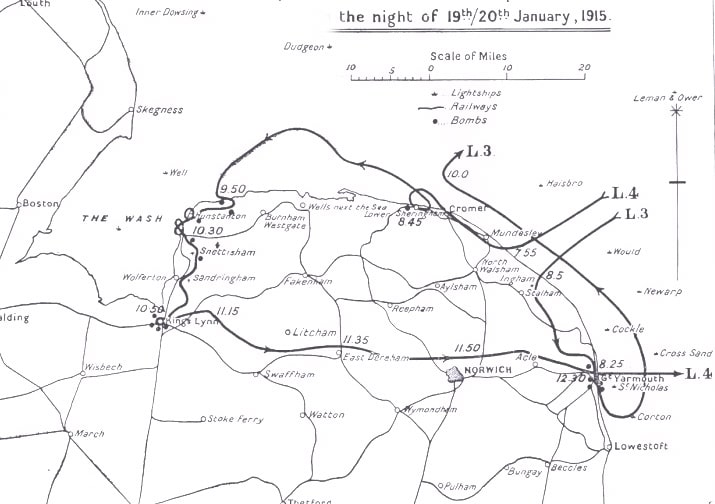Great Yarmouth History
Great Yarmouth to Kings Lynn

Route of Zeppelin's L3 and L4
On the morning of January 19th 1915 two German Imperial Navy Zeppelin airships, the L3 and L4 took off from Fuhlsbüttel in Germany. Both airships carried 30 hours of fuel, 8 bombs and 25 incendiary devices. They had been given permission by the Emperor Wilhelm II to attack military and industrial buildings on Humberside.
Zeppelin L6 which took off from Nordholz in Germany was to attack targets in the Thames Estuary but with express orders from Kaiser Wilhelm that there were to be no attacks on London itself owing to concern for the British Royal family to whom the Kaiser was related. However engine problems forced the L6 home before reaching the English coast.
Zeppelins L3 and L4 plans to attack the Humber were foiled by bad weather. They were forced to switch their attacks to the coastal towns of Norfolk. Zeppelins L3 and L4 crossed the coast of East Anglia, north of Great Yarmouth. Zeppelin L3 curving south east towards Great Yarmouth and Zeppelin L4 turned north west towards Kings Lynn. Incendiary bombs were dropped to enable the pilots to navigate to their chosen locations as the Zeppelins never crossed the coast until after dark.
Zeppelin L3 found Great Yarmouth and dropped its bombs killing Samuel Alfred Smith, the first British civilian to be killed by aerial bombardment. Martha Taylor was the second person killed and a further three were injured as a result of the attacks by Zeppelin L3.
| Bomb 1 | Having crossed the Norfolk coast between Happisburgh and Winterton, L3 dropped parachute flares as it navigated its way from Martham towards Yarmouth. Along the way, it dropped a first incendiary which landed in a waterlogged paddock on farmer George Humphrey's land at Little Ormesby, near St Michael's Church. Apart from a small crater, a foot and a half wide it did no damage. |
| Bomb 2 | The first bomb to hit Yarmouth was another incendiary which fell on the lawn of Norwood Suffling's house at 6, Albermarle Road, near the Wellesley recreation ground, gouging a crater two feet wide. |
| Bomb 3 | The first explosive bomb struck the pavement at the back of 78, Crown Road, but failed to explode. It was recovered by reservists and later defused. Aside from slicing off part of a gatepost, it too caused more alarm than damage. |
| Bomb 4 | The most destructive of all the bombs to fall on Yarmouth, the fourth bomb burst with shattering effect in the thickly-populated working class area of St Peter's Plain, near the Drill Hall. Spinster Martha Taylor and shoemaker Sam Smith were killed instantly and two more people were injured. The explosion blew out the front of St Peter's Villa and so seriously damaged nearby Pestell's Buildings that they had to be demolished. Many other homes suffered blast damage. |
| Bomb 5 | Another explosive bomb, this one failed to detonate and was recovered from a stable owned by butcher William Mays in Garden Lane, near South Quay. |
| Bomb 6 | The sixth missile crashed to earth, trailing a 'huge, fiery flame', outside the First and Last tavern in Southgate Road, by the Fish Wharf. Miraculously, there were no casualties, although a number of people who were nearby had narrow escapes. Damage was confined to broken windows and a hole torn in the road. |
| Bomb 7 | A third incendiary to be dropped fell between two vessels and caused some damage to Beeching's South Dock. |
| Bomb 8 | The third unexploded bomb of the night, it bounced off the Stone Quay at Trinity Wharf, narrowly missing a sentry and a crane turntable, before plunging harmlessly into the river. |
| Bomb 9 | Another explosive bomb, this one fell behind the Fish Wharf, causing extensive damage. As well as wrecking a dockside restaurant, it burst a water main, shattered windows and removed roof tiles. Incredibly, though, only one person was slightly hurt by flying glass. |
| Bomb 10 | Shrapnel from this bomb riddled the steam drifter Piscatorial owned by the hapless Harry Eastick, who had already lost one boat in the war to a mine. |
| Bomb 11 | The last bomb to fall during L3's 10-minute attack, it struck the road running along the back of the racecourse grandstand on South Denes, killing a dog and demolishing a fence. |
When Zeppelin L4 parted company with Zeppelin L3 it followed a route over the coastal villages of Brancaster, Sheringham, Holme-next-the-Sea, Heacham, Snettisham, Dersingham until it finally came to Kings Lynn, bombing as it went. Zeppelin L4 dropped the first bomb to fall on Britain soil at Sheringham, on the north Norfolk coast. Fortunately it did not explode, and was taken away by a local resident, who put the bomb in a bucket. A second bomb was dropped on Sheringham which did detonate but caused no damage. Casualties were inflicted at Kings Lynn where Percy Goate(14) and Alice Gazely(26) were killed. Alice Gazely's husband being killed in France a few weeks earlier.
Zeppelin L4 was under the command of Kapitanleutnant Count Magnus von Platen-Hallermund who was born in Vienna on June 7th, 1880. His combat report described a mission which included battles over heavily fortified towns with barrages of anti-aircraft fire. All pure fantasy - not a shot was fired at the Zeppelins. The Count survived the First World War and was killed during an air raid on Hamburg on July 21st, 1943.
Zeppelin L4 was lost over Denmark on February 17, 1915. The ship was damaged by bad weather and was forced to land. As the crew abandoned ship the lightened craft suddenly rose, with four of the crew still on board. Zeppelin L4 and the remainder of the crew were never seen again.